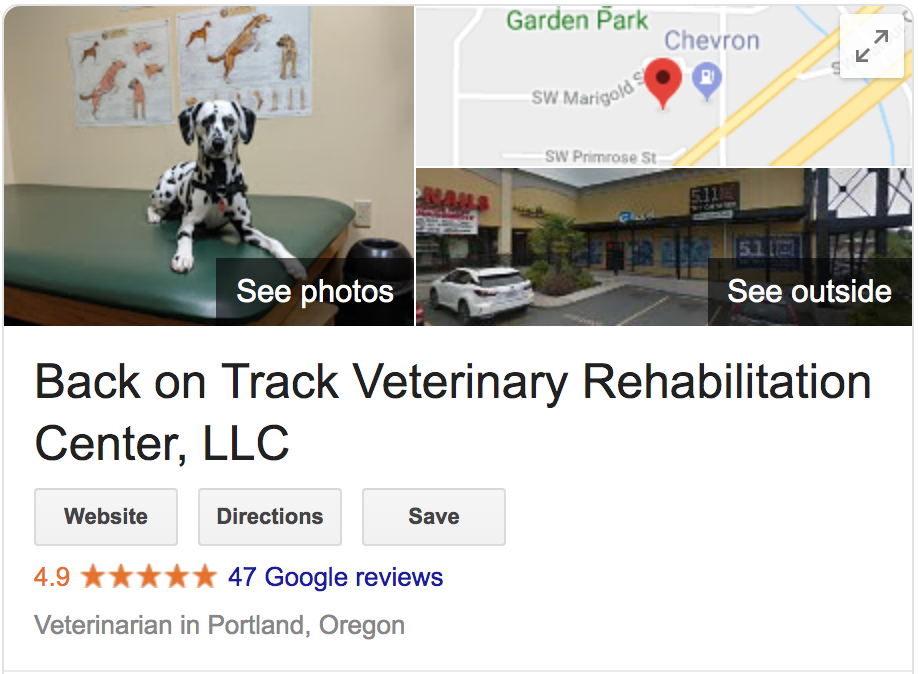Laurie's Blogs.
Jun 2019
Guest Blog - Long Term Patients

A question came up on a Vet-Rehab chat group. Essentially, a question had been posed by a rehab vet in regards to a long-term client that wasn’t improving or rather was sort of slowly deteriorating (as old dogs do). The question was along the lines of what do you do? Do you keep seeing the dog even though you aren’t making progress anymore?
Well the best response came from Dr. Bianca Shaw, of Back on Track Vet Rehab in Portland, Oregon. With her permission, I am providing it to you here.
“Having been at this for almost 20 years, I have had this scenario multiple times. I think, first, you should recognize that we are often goal-motivated, not just goal-oriented. So, think about changing your goal.
Specifically, for this case, what can you provide to maintain and sustain his function and comfort? Consider the home circumstances and lack of motivation obstacles as limitations, just as spinal walking is for a number of our patients. But they shouldn’t discourage you, because they do not reflect on you or your abilities. I know it’s exciting to see an animal graduate from the need for our services, but honestly, how much do you attribute to their inherent ability to thrive in the right circumstance, rather than take the credit?
What about the clients who are limited in their ability to perform HEP because of their own physical limitations? I will increase frequency if it is indicated to reach a specific goal, if what I can accomplish (in-house or in-patient) can advance or overcome certain issues (pain, specific muscle or motor control, giant size dogs). So, I look at what I think is needed and how long it might take, then re-evaluate after that time. For some long-term patients that seem to be slipping or have a new injury, I might recommend 6 weeks of weekly acupuncture or UWTM, then see what we are able to achieve. If I feel that we are losing pain control or running out of medication options, then it’s also time to reconsider frequency.
I have a number of patients that need monthly maintenance and if we try to lengthen the interval, they decline. I have a number that need shorter intervals. I had a greyhound with a front limb paralysis (imagine trying to keep a pancake on edge, too skinny to stand on his own, with unilateral cervical and radial nerve paralysis using the injured leg as a crutch) that came in twice a week for 5 years, at the owners’ request. But I kept him walking and rehabbed him from several laparotomies. I performed the movements that he couldn’t just like a cerebral palsy case. His body did not have the ability to integrate and build better function, but he needed to avoid contracture that would distort his posture further. He was too smart, and too obstinate to put up with the same exercises for more than a few sessions, so I had to be constantly thinking of ways to get him to work muscles to maintain flexibility. He was the best at getting people to do the work for him, and EVERY new staff or visitor had to be told that as he tried to play them. It was like a very long chess game. He also worked for premium treats, imported meats and cheeses, which his owners supplied, luckily. I had one dog that got frozen yogurt, one that got things like potato salad.
And I have the dachshunds that won’t take my treats, hide when I come in the room, and act like I am causing them mortal pain, even when I am barely touching. But I still offer the treat and leave it on the table, still pet them and rub them once I have them in my hands, insist on playing my “game or routine” rather than give into theirs, praising and murmuring (even when they’re deaf). These are often cases that are in the “monitor and maintain” phase that need weekly, biweekly, monthly or quarterly visits, where they weren’t good for longer intervals. I know they will have further problems and try to reduce the severity by catching things early (which is often the only time they act grateful). I started Rehab with the idea that we were NOT supposed to have a maintenance phase, because human PTs [physiotherapists] couldn’t charge insurance for it. Well, we can and we do, because it’s right.
Enough stories, just remember, we will have non-compliant owners and patients, just as we did in regular practice. It is the character of the case, not our character that is at fault. I love my athletic patients that need to be kept occupied, as well as my geriatrics that need to kept active. Each one is a challenge with its own reward. Don’t try to scale the insurmountable.
Hang in there, as it is all a process, not an endpoint. I’m sure most of us can relate. We do physical, emotional and psychological rehab for our patients, clients, staff, and each other. The reimbursement is not only monetary.”
Bianca Shaw, DVM,
Back on Track Vet Rehab
http://www.botvrc.com/


